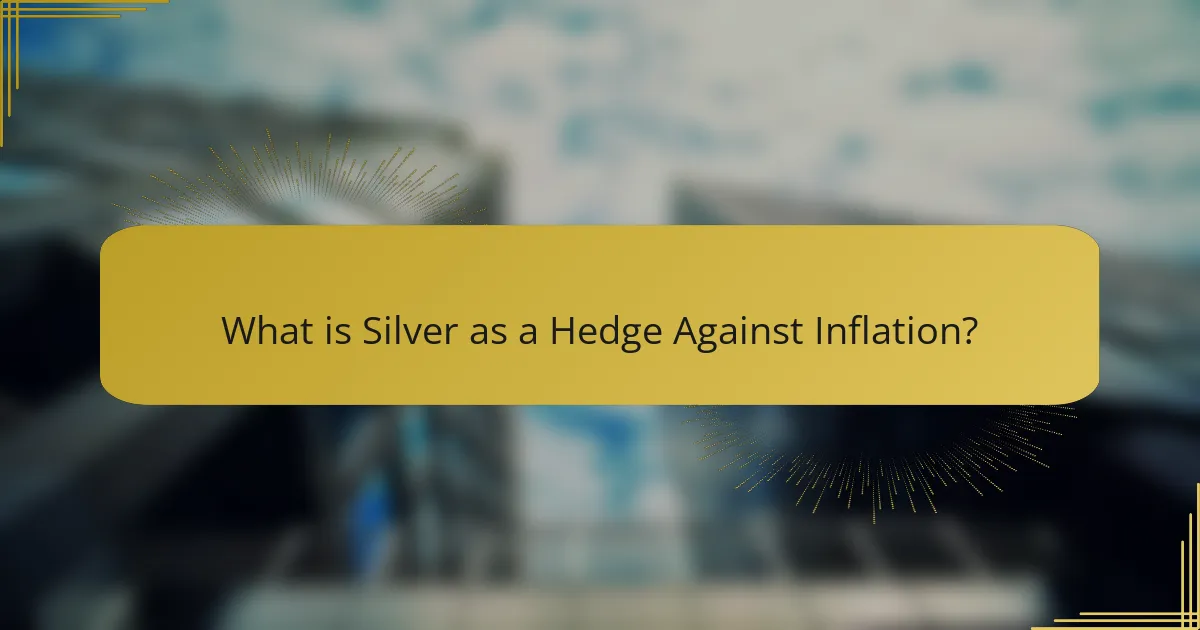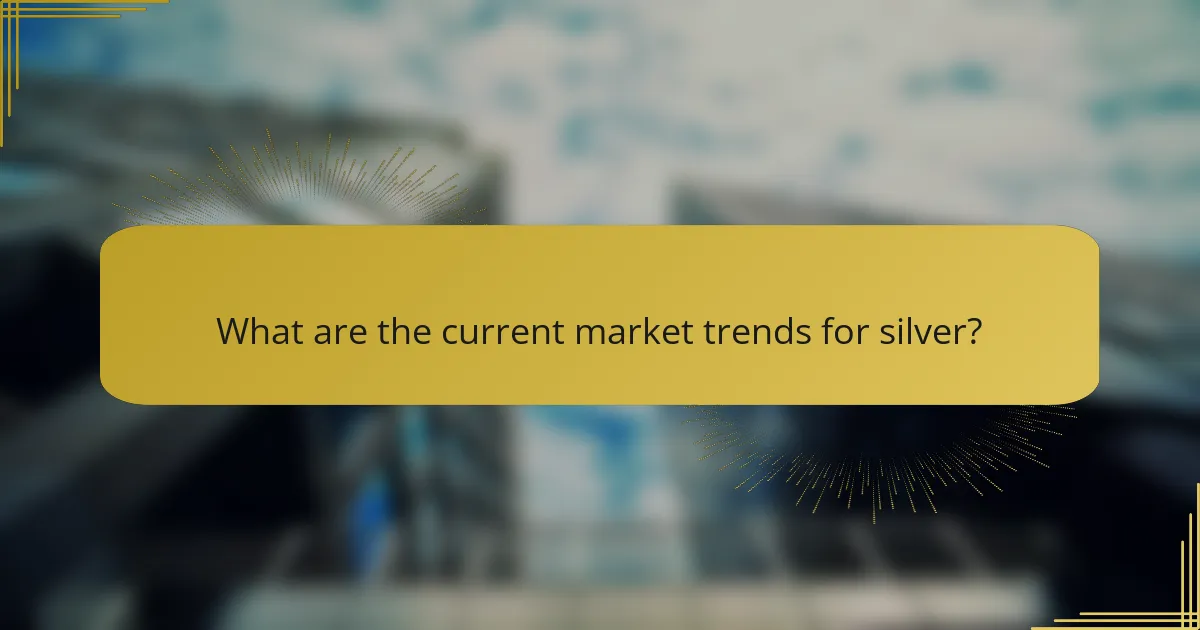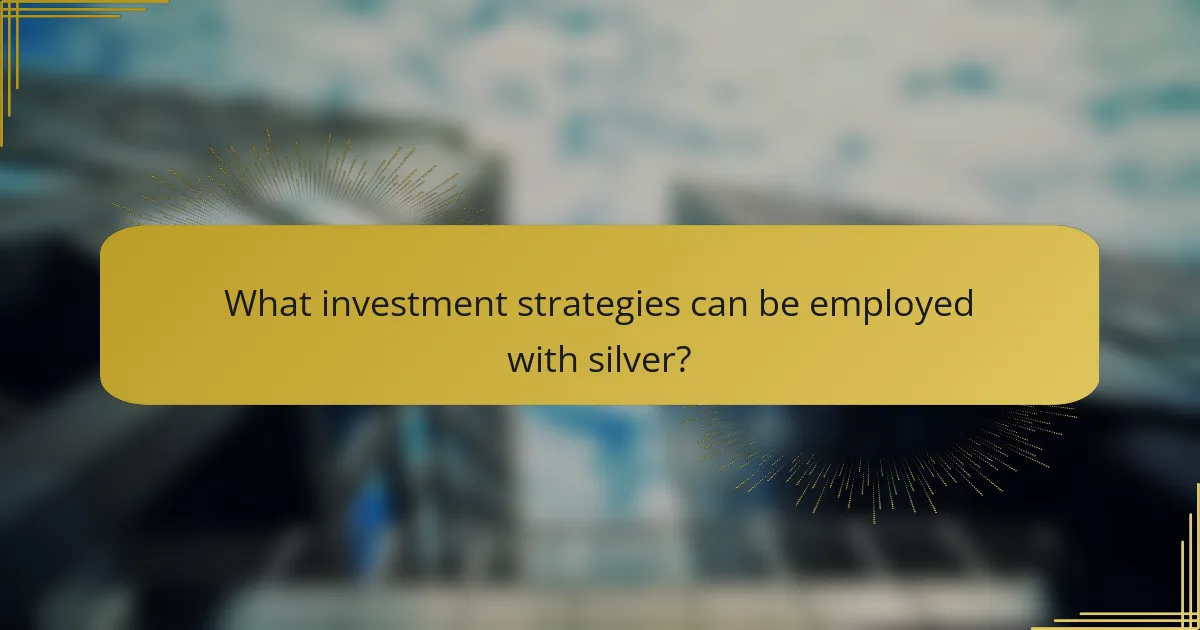Silver is recognized as a reliable asset for hedging against inflation, maintaining its value when currency purchasing power declines. Historical data indicates that during periods of high inflation, silver prices tend to rise, making it an attractive option for investors seeking to protect their wealth. Current market trends show a growing demand for silver due to economic uncertainty, with prices increasing by approximately 15% over the past year. Investment strategies include purchasing physical silver, investing in silver exchange-traded funds (ETFs), and trading silver mining stocks or futures contracts. The article will explore these aspects, highlighting silver’s historical performance, current market conditions, and various investment approaches.

What is Silver as a Hedge Against Inflation?
Silver serves as a hedge against inflation by maintaining its value when currency purchasing power declines. Historically, during periods of high inflation, silver prices tend to rise. For example, in the late 1970s, silver prices surged as inflation reached double digits. Investors often turn to silver to protect their wealth in uncertain economic times. This trend is supported by data showing that silver has outperformed other assets during inflationary periods. Additionally, silver’s industrial demand and limited supply contribute to its price stability. Thus, silver is viewed as a reliable asset for preserving value against inflationary pressures.
How does silver function as a hedge against inflation?
Silver functions as a hedge against inflation by maintaining its value when currency purchasing power declines. As inflation rises, the cost of goods increases, leading investors to seek tangible assets. Silver, being a precious metal, often retains its value or appreciates during inflationary periods. Historical data shows that during high inflation years, silver prices tend to rise. For instance, in the 1970s, silver prices surged as inflation reached double digits. This trend reinforces silver’s role as a protective asset against currency devaluation. Investors view silver as a safe haven, similar to gold, due to its intrinsic value and historical performance during economic uncertainty.
What are the economic principles behind using silver as a hedge?
Silver serves as a hedge against inflation due to its intrinsic value and historical stability. The economic principle of supply and demand plays a crucial role in this. When inflation rises, the purchasing power of currency declines. Investors often seek tangible assets like silver to preserve wealth.
Silver has a long history as a store of value. During economic downturns, its price tends to increase as demand rises. Historical data shows that during periods of high inflation, silver prices often outpace those of fiat currencies.
Additionally, silver is used in various industries, which supports its value. Its dual role as both an investment and an industrial metal enhances its appeal during economic uncertainty. Thus, using silver as a hedge is grounded in its historical performance and intrinsic properties.
How does silver compare to other inflation hedges?
Silver serves as an effective hedge against inflation, comparable to gold and real estate. Historically, silver has maintained its value during inflationary periods. For instance, during the 1970s inflation in the U.S., silver prices surged significantly, reflecting its protective qualities. Unlike stocks or bonds, silver often retains intrinsic value as a tangible asset. According to a study by the World Gold Council, silver’s price tends to rise with inflation, similar to gold. However, silver is more volatile than gold, which can result in higher short-term price fluctuations. In summary, while silver is a reliable inflation hedge, its volatility distinguishes it from other assets like gold and real estate.
What are the historical trends of silver during inflationary periods?
Silver typically rises in value during inflationary periods. Historical data shows that during the 1970s inflation surge, silver prices increased significantly. From 1971 to 1980, silver prices rose from approximately $1.50 to over $50 per ounce. This trend indicates a strong correlation between inflation and silver price increases. Similarly, during the 2008 financial crisis, silver prices surged as inflation fears grew. In 2020, amid the COVID-19 pandemic, silver again saw substantial price increases. These patterns suggest that investors often turn to silver as a safe haven during inflationary times.
How has silver’s price reacted during past inflationary crises?
Silver’s price has historically increased during past inflationary crises. For instance, during the 1970s inflation surge, silver prices rose significantly, reaching around $50 per ounce by 1980. This was a response to rising inflation rates, which peaked at over 13% in the U.S. during that period. Similarly, during the 2008 financial crisis, silver prices spiked as investors sought safe-haven assets amidst economic uncertainty. The price reached approximately $21 per ounce in 2008, reflecting heightened demand for precious metals. These trends indicate that silver often serves as a hedge against inflation, with its value increasing in response to rising consumer prices and economic instability.
What patterns can be observed in silver’s performance over decades?
Silver has exhibited significant price volatility over the decades. This volatility often correlates with economic events and inflation rates. For example, during the late 1970s, silver prices surged due to high inflation and geopolitical tensions. In contrast, the 1980s saw a decline as market stabilization occurred.
The 2000s marked a resurgence in silver prices, driven by growing industrial demand and investment interest. The financial crisis of 2008 led to another spike, as investors sought safe-haven assets. More recently, from 2020 onwards, silver experienced a notable increase, influenced by pandemic-related economic concerns and stimulus measures.
Overall, silver’s performance shows patterns of sharp increases during economic uncertainty and inflationary periods, followed by corrections in more stable times. These trends indicate silver’s role as a hedge against inflation and a reactive asset in financial markets.

What are the current market trends for silver?
Current market trends for silver indicate a rising demand due to economic uncertainty. Recent data shows that silver prices have increased by approximately 15% over the past year. Investors are turning to silver as a safe-haven asset amid inflation concerns. Industrial demand for silver is also growing, particularly in electronics and renewable energy sectors. Additionally, silver’s role in jewelry manufacturing remains significant, contributing to its overall market strength. Analysts predict that these trends may continue as global economic conditions evolve.
How is the demand for silver influenced by inflation expectations?
The demand for silver is positively influenced by inflation expectations. When inflation is anticipated, investors often seek tangible assets like silver to preserve value. This behavior stems from silver’s historical role as a hedge against inflation. For instance, during periods of high inflation, such as the 1970s, silver prices increased significantly. According to data from the World Silver Survey, silver demand surged by 10% in 2021 amid rising inflation concerns. As inflation expectations rise, the urgency to invest in silver typically increases, driving up its demand.
What industries drive the current demand for silver?
The primary industries driving the current demand for silver are electronics, solar energy, and jewelry. The electronics industry utilizes silver for its excellent conductivity in components such as circuit boards and connectors. In 2022, the electronics sector accounted for approximately 30% of global silver demand. The solar energy industry relies on silver for photovoltaic cells, which convert sunlight into electricity. This sector’s demand has increased significantly, with solar panels using about 80 million ounces of silver annually. Jewelry manufacturing also plays a crucial role, as silver is favored for its aesthetic appeal and affordability. In 2022, jewelry accounted for around 20% of the total silver demand. Additionally, the automotive industry is emerging as a new driver due to the increasing use of silver in electric vehicles and advanced driver-assistance systems. These industries collectively reflect the growing and diverse applications of silver in modern technology and consumer products.
How do geopolitical factors affect silver prices?
Geopolitical factors significantly influence silver prices. Political instability often drives investors toward safe-haven assets like silver. For instance, during conflicts or tensions, demand for silver typically increases. This heightened demand can lead to higher prices. Economic sanctions and trade wars also impact silver availability and pricing. For example, sanctions on major silver-producing countries can restrict supply. Historical data shows that silver prices surged during major geopolitical events, such as the Gulf War. Thus, geopolitical factors play a crucial role in shaping silver market dynamics.
What are the predictions for silver prices in the near future?
Predictions for silver prices in the near future indicate a potential increase. Analysts suggest that ongoing inflation concerns and economic uncertainty may drive demand for silver. Historical data shows that during inflationary periods, silver often performs well as a hedge. For instance, in the last inflation spike from 2020 to 2021, silver prices rose significantly. Current market trends also reflect a growing interest in precious metals. As of late 2023, forecasts estimate silver could reach between $25 and $30 per ounce in the coming months. This aligns with trends observed in past economic cycles.
What economic indicators should investors monitor?
Investors should monitor several key economic indicators. These include inflation rates, interest rates, and unemployment rates. Inflation rates indicate the purchasing power of currency. Higher inflation often leads to increased interest in precious metals like silver. Interest rates affect borrowing costs and can influence investment decisions. Lower interest rates typically boost demand for silver as an investment. Unemployment rates provide insight into economic health. Higher unemployment can lead to increased demand for safe-haven assets like silver. Additionally, GDP growth rates reflect overall economic performance. Strong GDP growth can enhance investor confidence in equities over precious metals. Monitoring these indicators can help investors make informed decisions regarding silver investments.
How do expert analyses forecast silver’s role in inflation hedging?
Expert analyses forecast silver’s role in inflation hedging as a valuable asset during economic uncertainty. Analysts highlight silver’s historical performance during inflationary periods. For instance, during the 1970s inflation crisis, silver prices surged significantly. This pattern suggests that investors often turn to silver as a safe haven. Additionally, current market dynamics indicate rising demand for silver in both industrial applications and investment. Reports from financial institutions predict that if inflation rates continue to climb, silver may see increased investment interest. Overall, expert analyses consistently show that silver retains its status as a reliable hedge against inflation.

What investment strategies can be employed with silver?
Investors can employ several strategies with silver. One common strategy is purchasing physical silver, such as coins or bars. This allows for direct ownership and can serve as a tangible asset during economic uncertainty. Another strategy is investing in silver exchange-traded funds (ETFs). These funds track the price of silver and provide liquidity and ease of trading.
Additionally, investors may consider silver mining stocks. These stocks can offer leveraged exposure to silver prices, as mining companies’ profits often increase with rising silver prices. Another approach is trading silver futures contracts. This strategy can provide high leverage but also involves significant risk.
According to the Silver Institute, silver has historically acted as a hedge against inflation. During periods of high inflation, silver prices tend to rise, making it a valuable addition to an investment portfolio. This historical data supports the effectiveness of these strategies in protecting wealth.
How can investors effectively buy and hold silver?
Investors can effectively buy and hold silver by purchasing physical silver, silver ETFs, or silver mining stocks. Physical silver includes coins and bars, which can be stored securely. Silver ETFs offer a way to invest in silver without the need for physical storage. Investing in silver mining stocks provides exposure to the silver market while potentially benefiting from company growth.
To buy silver, investors should research reputable dealers for physical silver purchases. They should also consider the premiums over spot prices when buying physical silver. For ETFs, investors can use brokerage accounts to buy shares. It’s essential to monitor market trends to determine the right time to buy and hold.
Historically, silver has acted as a hedge against inflation, maintaining value during economic downturns. According to the Silver Institute, silver demand has increased significantly in industrial applications, which supports its long-term value.
What are the different forms of silver investment available?
The different forms of silver investment available include physical silver, silver ETFs, silver mining stocks, and silver futures. Physical silver consists of bullion bars and coins that investors can buy and store. Silver exchange-traded funds (ETFs) allow investors to gain exposure to silver without owning the physical metal. Silver mining stocks represent shares in companies that extract silver, providing indirect investment in the commodity. Silver futures are contracts to buy or sell silver at a predetermined price on a future date. Each form offers unique benefits and risks, catering to different investment strategies.
What are the risks associated with investing in silver?
Investing in silver carries several risks. Price volatility is a significant risk, as silver prices can fluctuate dramatically. Market demand influences these price changes, which can be unpredictable. Economic downturns can reduce industrial demand for silver, impacting its value. Additionally, silver does not generate income, unlike stocks or bonds. Storage and insurance costs also add to the investment burden. Regulatory changes can affect silver markets and prices. Lastly, liquidity risk exists; selling silver may take time, especially in a downturn.
What are the best practices for diversifying a portfolio with silver?
To diversify a portfolio with silver, investors should consider allocating a specific percentage of their total investments to silver assets. A common recommendation is to allocate 5-10% of the portfolio to silver. This allocation helps mitigate risk while benefiting from silver’s potential appreciation.
Investors can choose between physical silver, such as coins and bars, and silver ETFs or mutual funds. Physical silver provides tangible value, while ETFs offer liquidity and ease of trading.
Regularly rebalancing the portfolio is essential to maintain the desired allocation. This involves adjusting the silver investment as market conditions change.
Monitoring market trends and historical data is crucial. Silver often performs well during economic uncertainty, making it a strategic addition during inflationary periods.
According to historical data, silver prices tend to rise when inflation increases. This characteristic reinforces silver’s role as a hedge against inflation.
Investors should also consider the correlation between silver and other asset classes. Silver often has a low correlation with stocks, providing additional diversification benefits.
Engaging with reputable dealers and conducting thorough research before purchasing silver is advisable. This ensures informed decisions and minimizes potential risks.
How much of a portfolio should be allocated to silver?
A typical allocation to silver in a diversified investment portfolio is between 5% to 10%. This percentage can vary based on individual risk tolerance and market conditions. Historically, silver has been viewed as a hedge against inflation and currency fluctuations. During periods of economic uncertainty, investors may increase their allocation to silver. This strategy is supported by data showing that silver prices often rise when inflation is high. Additionally, silver has a lower correlation with traditional asset classes, which can enhance portfolio diversification.
What strategies can mitigate risks when investing in silver?
Diversifying investments is a key strategy to mitigate risks when investing in silver. By spreading investments across various asset classes, the impact of silver price fluctuations can be reduced. Employing dollar-cost averaging is another effective method. This approach involves investing a fixed amount regularly, regardless of silver prices. It helps to avoid the pitfalls of market timing.
Monitoring market trends is essential for informed decision-making. Staying updated on economic indicators can provide insights into silver price movements. Setting stop-loss orders can also protect against significant losses. These orders automatically sell silver when prices drop to a predetermined level.
Investing in physical silver, such as coins or bars, offers a tangible asset. This can provide security during market volatility. Alternatively, silver ETFs allow for easier trading and liquidity. They also provide exposure to silver without the need for physical storage.
Finally, understanding the factors that influence silver prices is crucial. Economic conditions, industrial demand, and geopolitical events can all affect values. By being aware of these influences, investors can make more informed choices.
What practical tips should investors consider when investing in silver?
Investors should consider diversifying their portfolio with silver to mitigate risk. Silver often acts as a hedge against inflation, providing stability during economic downturns. It is essential to analyze market trends before making purchases. Monitoring silver prices can help identify optimal buying opportunities. Investors should also consider the form of silver they wish to invest in, such as bullion, coins, or ETFs. Each form has different liquidity and cost implications. It’s advisable to stay informed about geopolitical factors that can influence silver prices. Historical data shows that silver has maintained value over time, particularly during inflationary periods. Lastly, consulting with financial advisors may provide tailored investment strategies for silver.
Silver is examined as a hedge against inflation, highlighting its historical ability to maintain value when currency purchasing power declines. The article discusses how silver prices typically rise during inflationary periods, supported by data from past economic crises. Key factors influencing silver’s value include industrial demand, geopolitical events, and market trends, along with various investment strategies for incorporating silver into a diversified portfolio. Additionally, it addresses the risks associated with silver investments and provides practical tips for investors.